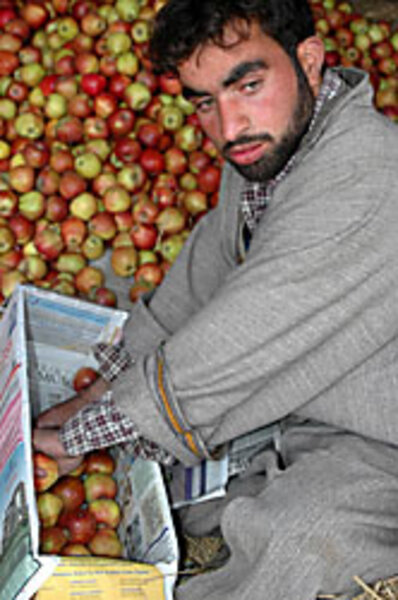Signs of thaw in bitter South Asian dispute
Loading...
| Baramullah, Indian Kashmir
Ghulam Rasul Butt believes the solution to Kashmir could begin with 1,038 boxes of apples.
That's what he sent to Muzaffarabad in Pakistani Kashmir on Oct. 21, marking the historic reopening of trade between the two halves of Kashmir – split between India and Pakistan – for the first time since 1947.
Trade, Mr. Butt says, could succeed where UN resolutions and three wars have failed. From cement to natural gas, India and Pakistan are turning to commerce to help forge common ground. The trade is largely symbolic, but it represents the first seeds of trust between the nuclear-armed enemies, whose squabbles have continually unsettled the region – including Afghanistan.
Kashmir trade "will help end the prolonged animosity between the two countries," says Butt, the president of the Kashmir Valley Fruit Growers Association.
Renewed trade across Kashmir's so-called Line of Control (LoC) – the 450-mile ribbon of Himalayan frontier that splits Kashmir and is lined on either side by nearly 1 million troops – is the most dramatic example of a gradual strengthening of economic ties between India and Pakistan. It is part of a broader trend.
Pakistani President Asif Zardari's government has steadily increased the number of items that India can export to Pakistan, adding 136 items in July – from diesel fuel to mining equipment – bringing the total to 1,938.
In September, Mr. Zardari and Indian Prime Minister Manmohan Singh agreed to open a new trade corridor between Gujarat and Sindh. Previously, only one cross-border trade route existed.
Pakistan is also leading an effort to establish a $7.6 billion natural gas pipeline from Iran through Pakistan to India, a plan which remains in negotiations.
In total, trade between the two countries has increased from $345 million in 2004 to $2.2 billion this year. The numbers might appears small – for India, trade with Pakistan represents less than 1 percent of its total trade.
But the measures are key first steps aimed more at establishing trust than turning South Asia into free-trade bloc, says D. Suba Chandran, an analyst at the Institute of Peace and Conflict Studies in New Delhi.
"Trade is seen as a political confidence-building measure, not an economic confidence-building measure," Mr. Chandran says.
A loosened 'Kashmir knot'?
The nascent cross-border commerce also reflects a growing realization in New Delhi and Islamabad that the two countries must somehow overcome past grievances. "The last four years have been the best in the India-Pakistan relationship," says Raja Mohan, a professor at the S. Rajaratnam School of International Studies in Singapore.
But they are brittle achievements in danger of being broken if the political temperature changes. "It is a trend, but it can be reversed very easily," says Salman Haider, a former foreign secretary of India.
In Baramullah, there is hope of the opposite – that economics could at last begin to loosen the Kashmir knot.
Above Baramullah, black fingers of bare apple trees scrabble a mist that wraps the Himalaya beyond, like cellophane moistened by the first breath of winter. Baramullah's lifeblood is its fruit industry, particularly apples. Butt estimates that 80 percent of Kashmiris in the valley – the heart of Kashmir – depend on the fruit industry. But the Kashmir Valley's historic link to the world is through Muzaffarabad – a route severed by the LoC.
Forced to trade only through India, goods from the valley had to pass southward through a mile-long tunnel. When the tunnel was closed during a series of protests this summer, apple growers lost $120 million, Butt says.
The opening of cross-LoC trade was a compromise that highlighted the flexibility needed to resolve the Kashmir question, says Masood Hussain, Kashmir writer for the Economic Times, an Indian newspaper.
In recent years, it has become clear that neither India nor Pakistan will cede any part of its Kashmir to the other, nor is either likely to support an independent Kashmir. The new trade points to what many analysts say must be the final solution: a semi-autonomous state shared between the two.
"If the borders are already drawn, there can only be an economic way out, and if economics is the solution, then that road [to Muzaffarabad] will be very important," says Mr. Hussain.
High hurdles remain for trade
Apple grower Butt notes that his fruit is not subject to customs duties when he sends them to Muzaffarabad. "We are not going to accept the Line of Control as a permanent border," he says. "It must be free trade ... between Kashmir and Kashmir."
For now, however, the new trade route has failed to do much of anything to help growers, he acknowledges. Instead, it has served primarily to highlight how much more needs to be done.
One lingering security measure means that there are no phone connections from Indian Kashmir to Pakistani Kashmir, making it difficult for Butt to conduct business across the LoC. Moreover, banks in India and Pakistan have no links, meaning neither Indian nor Pakistani Kashmiris can cash the others' checks. Until these banking ties are established, a portion of the business is done by bartering Pakistani onions and pomegranates for Indian apples. The Indian government then sends a delegation of farmers to Pakistan to pick up the balance in cash.
A total of 21 curiously specific items can be traded across the LoC – from apples to leather slippers, walnut-wood furniture, and pillow covers. Combine these limitations with five-hour delays at the LoC, where Indian authorities make drivers unload every box for inspection, and the cross-LoC trade has been understandably minuscule.
On Oct. 21, for example, the Kashmir Valley produced about 425,000 boxes of apples. The 1,038 shipped to Pakistani Kashmir were 0.2 percent of that total.
Nonetheless, Butt is happy to be patient. "This is our own route," he says, speaking as a Kashmiri. "As the Berlin Wall was brought down, we will bring the Line of Control down."






